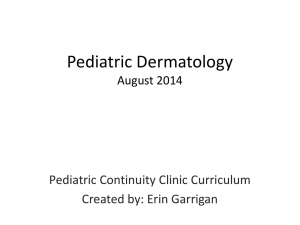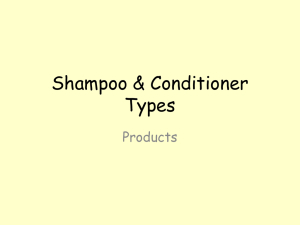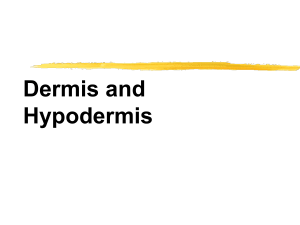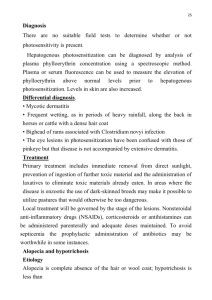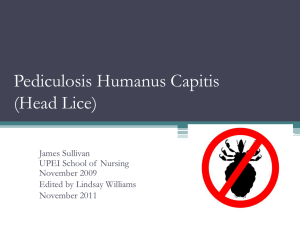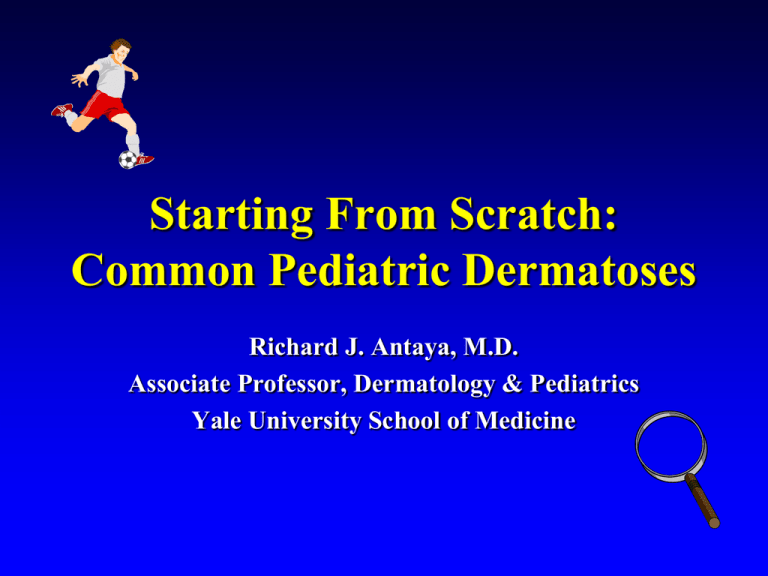
Starting From Scratch:
Common Pediatric Dermatoses
Richard J. Antaya, M.D.
Associate Professor, Dermatology & Pediatrics
Yale University School of Medicine
IMPETIGO CONTAGIOSA
•
•
•
•
Both Staph aureus and Strep pyogenes
Humid climates and summer months
Secondary to trauma and insect bites
Treatment
– Oral - cephalexin. dicloxacillin, amoxicillinclavulanate, erythromycin, cefaclor
– Topical - mupirocin (Bactroban), retapamulin
oint 1% (Altabax), soak off crusts
Bullous Impetigo
• Always Staph aureus
• Epidermolytic toxin cleaves stratum
granulosum
• Phage group II
• Same toxin as Staph Scalded Skin
Syndrome
• Rx: Oral anti-Staph antibiotics
Lyme Disease
•
•
•
•
multi-stage, multi-system disease
agent:Borrelia burgdorferi, vector: Ixodes ticks
late spring to mid fall
Erythema Migrans (previouslyECM) in 80%
– expanding, erythematous, round or oval areas
– solitary or multiple, concentric rings
– variable induration, pain, pruritus
• untreated cases - arthritis, neurologic, cardiac,
ophthalmic complications
Lyme Disease
Treatment
• young children – amoxicillin
• older children/adults - doxycycline
Tinea Corporis Pearls
• Fungal infection of the superficial epidermis
• KOH wet prep for diagnosis
–
–
–
–
Scrape with edge of glass slide; not scalpel
Apply one drop Chlorazol Black E fungal stain
Place coverslip
Scan on low power with condenser at lowest point
• “If it’s scaly…scrape it!”
• Don’t get CLIAphobia
Tinea Corporis Treatment Pearls
• Topical azole* unless widespread
• Treat b.i.d. for 2 to 4 weeks
• Terbinafine, naftifine, butenafine, ciclopirox
– Fungicidal
– $econd line
• Look for source
* clotrimazole, ketoconazole, miconazole, econazole
Granuloma Annulare
•
•
•
•
•
•
•
•
Small, firm papules form annular plaque
Skin-colored, dusky to violaceous
No scale (- epidermal, + dermal inflammation)
Acral locations
Necrobiosis (destruction) of dermal collagen
Subcutaneous - deep nodules
Periosteal – “bony” hard; over scalp, tibia
No treatment, no associations, reassurance
TINEA CAPITIS
• Dermatophyte infection of the hair shaft
• Presentation
– hair loss and/or multiple “black dots”
– patchy areas of scale
– lymphadenopathy
• Common in African-American children
• Usually caused by Trichophyton tonsurans (does
not fluoresce)
TINEA CAPITIS
• Oral griseofulvin 20-25 mg/kg/day in a
single dose with fatty food
• Treat for 6 - 12 weeks
• Adjunctive use of selenium sulfide (Selsun
Blue), ketoconazole, or ciclopirox shampoo
may decrease fungal shedding
TINEA CAPITIS Alternative Therapies
• Terbinafine (Lamisil) 5-8 mg/kg/d, 4-6 wk
– Oral granules FDA approved
• Itraconazole (Sporonox) – 5-6 mg/kg/d
– Liquid contains cyclodextrin
• diarrhea, pancreatic adenomas in rats
• Fluconazole (Diflucan) – 6 mg/kg/d
– no more effective than griseofulvin*
Br J Dermatol 1996;135:86-88
AAD poster New Orleans, LA 2005*
KERION
• Boggy, highly inflammatory reaction
• Bacteria may be cultured (Staph)
• Treatment
Griseofulvin
Prednisone (1-2mg/kg/day) for ~5 days
+/- Oral antibiotics
Id Reaction
Distinguish from
Drug
hypersensitivity
Urticaria
• Edematous, erythematous papules
• Lineup along hairline, postauricular,
• Atopic dermatitis distribution
TINEA VERSICOLOR
• Malassezia furfur(Pityrosporum orbiculare)
• More common in adolescents and adults
Treatment
• Overnight selenium sulfide solution/
shampoo (1% OTC and 2.5% Rx)
• Ketoconazole 400 mg P.O. in a single dose,
may repeat in one week
SCABIES
DIAGNOSIS
1. Hx of intractable itching
2. Hx of possible exposure
3. Character and distribution of
lesions
4. Microscopic exam of skin
scrappings
SCABIES
In Older Children
Distribution
anterior axillary lines
inner aspect of upper arms
areolae
penis
wrists and interdigital webs
ankles
SCABIES
Infants
• Diffuse eczematous dermatitis
• Frequently involves entire cutaneous
surface (face, palms, soles)
• Inflammatory nodular lesions of axillae /
diaper area of very young
• Burrows, papules, vesicles and pustules
SCABIES
TREATMENT
• 5% permethrin cream (Elimite)
– Total body in infants and older children
– Don’t recommend neck to toes
– 8-14 hour (overnight); repeat in 7 days
• Ivermectin (Stromectol)
– 2nd line, 200 mcg/kg, repeat 1 week
• Wash clothing / bedding >120oF next a.m.
• Treat all close contacts
• Treat the “patient”
– Moderate potency topical steroids
Louse: 6-legged, wingless,
translucent, 2-3 mm
Head Lice
Myths vs Facts
• Don’t affect only “dirty” individuals
• Not linked to poor hygiene or living
conditions
• Don’t jump or fly
• Location of nit varies with temperature and
humidity (1/4 – 6 inches)
Pediculosis Capitis
Head Lice
• Symptoms
– nocturnal pruritus
– red macules on nape of neck and scalp
• Don’t spread any other disease, rare
impetigo, malaise
• Transmission: head-to-head contact
Head Lice Diagnosis
•
Combing vs Visual inspection
– 4x more effective
– 2x faster
•
Combing hair with nit comb
– Teeth spacing 0.2-0.3 mm
– Wet hair may be more effective
•
Procedure
–
–
–
–
–
–
–
•
Routine comb or brush
Insert louse comb at crown
Gently touches scalp
Draw firmly down, angle distally
Comb systematically at least twice
Examine comb after each pass
Usually 1 minute to find first louse
Nurses out-perform MDs
Head lice/nit combs
Mumcuoglu KY et al. Pediatr Dermatol 2001;18:9-12
Pediculosis Capitis
First-line Treatment
• FDA-approved OTC
–
–
–
–
0.3% pyrethrins (RID), permethrin 1% (Nix)
Apply to scalp 10 min and rinse
Repeat 8-10 days
Apply 1:1 vinegar:H20, enzyme solution to enhance
combing
– Comb with metal nit comb
• Re-examination for live lice (nurse preferably)
after another 8-10 days
• Cost ~$20 for 1-2 treatments
Adapted from Guidelines for the Treatment of Resistant Pediculosis; 6/14/99
Pediculosis Capitis Second Line Treatment
• If live lice present after 2 OTC treatments
• malathion lotion 0.5% (Ovide®)
• Side effects: scalp irritation, dandruff, conjunctivitis,
flammable until dries
• 7 days after the treatment 90% were lice free
• Application
–
–
–
–
To dry hair-thoroughly wet hair and scalp
Allow to dry uncovered
Shampoo hair after 20 min – 8 hr, nit combing
Only repeat in 7-9 days if lice still present
• Supplied 2 oz bottles (1 application = $206)
Adapted from Guidelines for the Treatment of Resistant Pediculosis; 6/14/99
5% Benzyl Alcohol Lotion
Ulesfia
• NEW FDA approved April 2009
• Kills head lice by asphyxiation w/o potential neurotoxic
SE
• > 6 months of age
• 2 PC studies for FDA approval – 628 pts
– Two 10-minute treatments, 1 week apart
– 14 days after the treatment 75% were lice free
– SE - irritation of the skin, scalp, and eyes, application site
numbness
– Avoid in premature infants - serious respiratory, heart- or brainrelated adverse events
• Now available
Ulesfia Lotion Usage Guidelines
Hair Length
• Short
– 0-2 inches
– 2-4 inches
Amount of Ulesfia Lotion/ Tx
$41.59/8oz
bottle
– 4-6 oz (½-¾ bottle)
– 6-8 oz (¾-1 bottle)
• Medium
– 4-8 inches
– 8-16 inches
Girl w/ long hair – 8-12 oz (1-1½ bottles)
– 12-24 oz (1½-3 bottles)
3 bottles x 2
• Long
=$249.54
– 16-22 inches
– 24-32 oz (3-4 bottles)
– > 22 inches
– 32-48 oz (4-6 bottles)
Pediculosis Capitis
Third-line Treatments
• Oral Bactrim
– Gram neg bacteria in lice GI tract
– 10 day course p.o. (dose for A.O.M)
untreated louse
(Speare et al)
• Nuvo lotion* Cetaphil Cleanser ®
–
–
–
–
–
Apply to scalp, dry with hair dryer
Rinse out next day, repeat qwk x 3
Nit removal unnecessary
96% cure
Suffocate the lice with hair drier
• Ivermectin
– P.O.- 200 mcg/kg x 1 on days 1 and 10
– 0.8% topical solution/shampoo
* Pearlman, D. L. Pediatrics 2004;114:e275-e279
Nuvo-treated louse coated
with dried-on lotion
Copyright ©2004 American Academy of Pediatrics
School Exclusion
• In 1998, 50% of US school nurses would
not allow a child with nits back into school
• Infestation present weeks before detection
• 75% with nits alone are not infested
• School exclusion not recommended by
American Public Health Association
• “No nit” policy is questionable ($367
million/yr lost)
WARTS
• Human papilloma virus (HPV)
• Verrucae vulgaris, plana, plantaris, and
condyloma acuminata
• Highest incidence in 10-19 y/o
• 25% disappear in 3-6 months
• 65% disappear in 2 years
WART THERAPY
•
•
•
•
•
•
•
•
Topical salicylic acid in collodion hs with paring
Cryotherapy with liquid nitrogen
Duct tape – apply for 6.5 days/week
Heat therapy
Pulsed Dye Laser *
Aldara (imiquimod 5% cream)
Immunotherapy (SADBE, skin test antigens)
Oral cimetidine x 2-3 months still controversial
* Adapted from Tan OT, Lasers in Surg and Medicine,1993, 13:127-37
Molluscum Contagiosum
•
•
•
•
•
•
•
Poxvirus infection of the epidermis
Mistaken for varicella or vesicles
Infectious (pools, fomites)… but benign
Inflamed, itchy, infected
Untreated lasts 2-48 months (avg 18 mo)
STD in adolescents and adults
Severe in HIV infected patients
Molluscum Contagiosum
Treatment
• Tincture of time
• Office-based therapy (q 2 weeks)
–
–
–
–
–
Cantharidin (Blister beetle juice) application
Liquid nitrogen cryotherapy
Curettage
Lacerate or lance with needle
Candida Antigen intralesional injection
• Home treatments
– Tretinoin (Retin-A) 0.025% gel with Q-tip qhs
– Imiquimod 5% cream (Aldara) q.d. to b.i.d.
ALLERGIC CONTACT
DERMATITIS
Acute lesions - erythema, vesiculation, oozing
Chronic lesions - dry and lichenified
Most common offenders
Toxicodendrons - Poison ivy, oak, sumac (~80%)
Metals (Ni) (10-15%)
Neomycin
Preservatives and fragrances
Shoes (chromates and rubber)
Black henna tatoos (ppd)
Prominent Pruritic Periumbilical Papules:
Allergic Contact Dermatitis (ACD) to Nickel
• 38 children with suspected ACD to nickel
• prominent subumbilical and periumbilical papules
• generalized, lichenoid papular dermatitis
resembling an id reaction
• patch testing performed in 9 (24%)
• all 9 (100%) patients had positive patch test results
for nickel, confirming the diagnosis
Adapted from Sharma V. Pediatric Dermatology. 19(2):106-9, 2002 Mar-Apr.
Cellphone Contact Dermatitis with
Nickel Allergy
• Tested numerous brands of cell phones
• Most common sites with nickel
– menu buttons
– decorative logos on the headsets
– metallic frames around the LCD screens
Berkovitch L, Luo J. CMAJ 2008;178(1):23-4.
Results of nickel spot testing of 23
wireless communication devices
•
CELLPHONE
•
BlackBerry 8700c Speakerphone (back of
phone)
BlackBerry Pearl None
Kyocera KX444 None
LG Verizon VX8300 None
Motorola L2 Headset (decorative logo)
Motorola Razr Headset (decorative logo)
Motorola SLVR Headset (decorative logo)
Motorola Q Headset (decorative logo)
Motorola i580 None
Motorola i870 None
Nokia 6061 None
•
•
•
•
•
•
•
•
•
•
•
•
•
•
•
•
•
Nokia 6062 None
Nokia 6820 None
Nokia 6230 None
Nokia 6682 None
Palm Treo 650 None
Samsung e105 Metal around the screen,
menu button
Samsung d807 Menu button
Sony Ericsson W600i Menu button
Sony Ericsson W810i Menu button
Sony Ericsson T610 Handset (if paint is
chipped)
Sony Z520a None
•
BLUETOOTH HEADSET
•
Plantronics Explorer 320 None
•
•
•
•
Berkovitch L, Luo J. CMAJ 2008;178(1):23-4.
Dimethylglyoxime
Positive test for Ni+
Metal jean clasps 10%
Belt buckles 53%
Byer TT. Periumbilical allergic contact dermatitis: blue jeans or belt buckles?.
Pediatric Dermatology. 21(3):223-6, 2004 May-Jun.
Dimethylglyoxime Nickel Test Kit
Allertest Ni
• Allerderm PO Box
2070 Petaluma CA
94953
• $12.50 + $6 S&H
• www.nickelallergy.com
• 800-365-6868
CONTACT DERMATITIS
TREATMENT
• Topical steroids - moderate potency
• 2 week course of oral prednisone if
widespread/facial
• May last for 1 to 3 weeks after exposure
• Identify allergen and avoid
PORT-WINE STAINS
Capillary Malformation
•
•
•
•
Will not involute, does not proliferate/spread
May darken and thicken
May become nodular w/ age
May become significant, lifelong cosmetic and
psychosocial problem
• Laser may be effective
Yale Vascular Anomalies
Clinic (VAC)
•Infantile hemangiomas
•Other vascular neoplasms
•Capillary malformations
•Lymphatic and other malformations
•Other vascular lesions – PG, angiokeratomas
Capillary Malformation“Port Wine Stain”
Pulsed Dye Laser Treatment
• response rate
–
–
–
–
–
variable
65% - 75% complete to considerable response
multiple treatments (5-20 average)
child versus adult
improved response
• anatomical site - forehead, lateral face, temple
• geographic
• recurrences can occur
SUN PROTECTION STATISTICS
•
•
•
•
skin cancer - most common malignancy in U.S.
1 million new skin cancers diagnosed in 1997
about 7,300 skin cancer deaths in 1996
malignant melanoma in U.S.
– 1973 - cases 5.7 /100,000; mortality of 1.6/100,000
– 1994 - cases 12.5/100,000; mortality of 2.2/100,000
– 41,600 new cases diagnosed in 1998
• sun is the cause of at least 90% of all skin cancers
SUN PROTECTION
• BCC / SCC associated with cumulative exposure
• melanoma associated with short, intense exposure,
possibly UVA
• blistering sunburns in childhood more than double
the risk of melanoma
• significant amount of lifetime sun exposure occurs
before age 18
• anticipatory guidance early is essential
Good Sun Sense
•
•
•
•
•
•
•
broad-rimmed hats
tightly woven clothing
sunscreens SPF 15 or more (> 6mo)
sun Guard by Rit ® in wash (UPF 530)
UV protective sunglasses
nature shade, limit midday exposure
avoid tanning beds!
Evaluating Hair Loss in Children
Localized
or
Diffuse
Congenital
or
Acquired
Acquired & Localized Hair Loss
1. Alopecia areata
2. Trauma
–
–
Trichotillomania / Hair pulling
Traction alopecia
3. Tinea capitis
Alopecia Areata
Alopecia Areata
HISTORY
Worse prognosis associated with
• disease present > 1 year or young age at onset
• positive family history of AA or atopy
• extensive involvement
– especially ophiasis pattern or alopecia totalis
• Down syndrome
TRICHOTILLOMANIA
Angular/geometric shapes
or borders
Linear lesions
Incomplete loss
Hairs of varying length
Perifollicular petechiae
and excoriations
Broken / twisted hairs
No scale
Hair Pulling
“Splitting Hairs”
1. Acute hair pulling associated with stress
2. Trichotillomania (OCD)
3. Hair pulling associated with other
psychiatric disorders
Hair thinning in
particular areas
Traction Alopecia
Follicular papules
Very few fractured hairs
Hair shafts smaller in
diameter
Hair care / style
R/O child abuse
RX: education , discontinue trauma
Pilomatricoma
Calcifying Epithelioma of Malherebe
•
•
•
•
•
•
•
•
•
Benign adnexal tumor from hair cortex
Rock-hard, bluish, “tent sign” 2 mm -1 cm nodule
Face > extremities
10% of all skin nodules/tumors in childhood
Most asymptomatic, inflammation in some
Spontaneous regression not reported
Surgical excision, recurrence < 5%
Familial 13.3% occurrences*
Multiple 26.7%
– Rubinstein-Taybi, Turner, Gardner syndromes
* Adapted from Pediatric Dermatology. 14(6):430-2, 1997 Nov-Dec.




